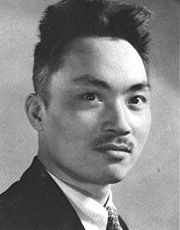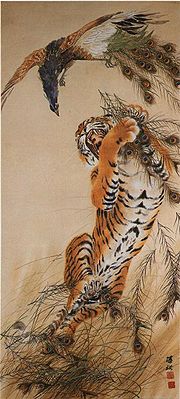
Hu Zaobin
Encyclopedia



Chinese people
The term Chinese people may refer to any of the following:*People with Han Chinese ethnicity ....
painter, famous for painting tigers.
Early life
Wu Cho Bun was born in the ShundeShunde
Shunde District is a district of Foshan prefecture-level city in the Pearl River Delta, Guangdong Province, southeast China.-Administration:Shunde was a county-level city until December 8, 2002, when it became a district of Foshan prefecture-level city...
Prefecture, Guangdong
Guangdong
Guangdong is a province on the South China Sea coast of the People's Republic of China. The province was previously often written with the alternative English name Kwangtung Province...
Province in 1897. Hu studied art in China
China
Chinese civilization may refer to:* China for more general discussion of the country.* Chinese culture* Greater China, the transnational community of ethnic Chinese.* History of China* Sinosphere, the area historically affected by Chinese culture...
and later went abroad to Japan
Japan
Japan is an island nation in East Asia. Located in the Pacific Ocean, it lies to the east of the Sea of Japan, China, North Korea, South Korea and Russia, stretching from the Sea of Okhotsk in the north to the East China Sea and Taiwan in the south...
to study Western fine arts at the Kyoto Municipal Art Institute where he developed his now distinctive and famous style of painting the tiger.
Painting career
In 1915, Wu found the Yeuk Yue Painting Research Institute at Si Pai-lou, Guangzhou with Feng Laiqiu. Yue Sze Art school was later established on Guongta Street in the same city a year later. In 1922, he was appointed as the Northern Expedition Army's Head Political Department Director of Publicity in the Art section.In 1928, he went on a tour within Southeast Asia in which he observed and took many photographs of wildlife became references in his later work. In 1931, Wu started working in Singapore as the Art Editor for the Singapore Daily.
In 1933, Wu returned to Guangzhou with his second wife and their children. They then moved to Shanghai with Wu's first family. He established Xingxiang Art Society along with Zhu Fengzhu, presented Chinese Modern Paintings Exhibitions with Wang Yiting, Zhang Yuguang, and Zhang Xiaolou.
When the Marco Polo Bridge Incident
Marco Polo Bridge Incident
The Marco Polo Bridge Incident was a battle between the Republic of China's National Revolutionary Army and the Imperial Japanese Army, often used as the marker for the start of the Second Sino-Japanese War .The eleven-arch granite bridge, Lugouqiao, is an architecturally significant structure,...
ignited the war between China and Japan, Hu held an exhibit to raise fund for the victims in Szechuan and Suiyuan provinces. When Shanghai fell to Japanese troops, Hu moved his family to Hong Kong and worked as an art teacher at Southwest (Sai Nam) Middle School.
Personal
In 1914, he became active in the KuomintangKuomintang
The Kuomintang of China , sometimes romanized as Guomindang via the Pinyin transcription system or GMD for short, and translated as the Chinese Nationalist Party is a founding and ruling political party of the Republic of China . Its guiding ideology is the Three Principles of the People, espoused...
(Nationalist Party) and married his first wife, Tan Fun-kwei in an arranged marriage. They had four daughters, three of them survived childhood.
In 1933, he met his second wife, Ng Wai-chun in Singapore and they got married. Together, they bore 3 daughters and one son.
Death
When the Japanese troops occupied Hong KongJapanese occupation of Hong Kong
The Japanese occupation of Hong Kong began after the Governor of Hong Kong, Sir Mark Young, surrendered the territory of Hong Kong to Japan on 25 December 1941 after 18 days of fierce fighting by British and Canadian defenders against overwhelming Japanese Imperial forces. The occupation lasted...
in 1942. Wu attempted to sneak back into rural China with his family but despite of his disguise, he was caught and had his paintings confiscated. He was pressured to help with the Japanese propaganda campaign but refused. Hu somehow managed to sneak out to Gianmun and later to Haipeng. He was infected by a deadly disease there and die at the age of 46 with his family besides him. "Righteousness Permits No Turning Back" was finished during that time.
Wu's family later immigrated to Canada
Canada
Canada is a North American country consisting of ten provinces and three territories. Located in the northern part of the continent, it extends from the Atlantic Ocean in the east to the Pacific Ocean in the west, and northward into the Arctic Ocean...
and the United States of America.
Art Exhibition
His widow Ng Wai-chun donated the painting "Righteousness Permits No Turning Back" to the Hong Kong Museum of ArtHong Kong Museum of Art
The Hong Kong Museum of Art is the main art museum of Hong Kong. The museum was established as the City Hall Museum and Art Gallery in the City Hall in Central by the Urban Council in 1962. In 1991, it was moved to the present premises at 10 Salisbury Road, near the Hong Kong Cultural Centre and...
after the art exhibition of Hu Zaobin concluded in August of 1987. It is currently on display at the 4th floor of Hong Kong Museum of Art.
In 2010, Museu de Arte de Macao will host a memorial art exhibition for Hu Zaobin for a period of six weeks beginning April 30th. After the conclusion of this exhibition, his family will donate 10 pieces of art works to the Mesuem de Arte de Macao for public viewing. A book of his artwork will also be publish to celebrate this event.

